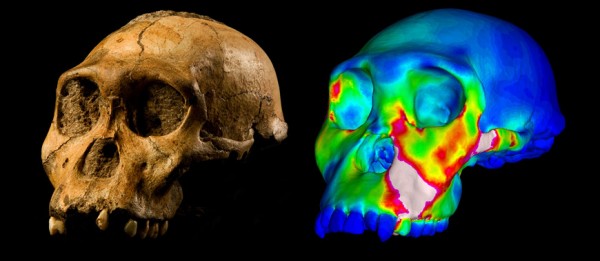By Ana Verayo, | February 09, 2016

The fossilized skull of Australopithecus sediba specimen MH1 and a finite element model of its cranium depicting strains experienced during a simulated bite on its premolars.
Prior studies of the prehistoric human species known as Australopithecus sediba revealed that these early hominids most likely subsisted on a complex diet of tree bark, nuts and leaves including other plant products, which was discovered in 2008 in South Africa.
Like Us on Facebook
However, in this new study, archaeologists reveal that the teeth and jaw structure of the A. sediba may have caused this extinct bipedal primate to dislocate its jaw when it attempts to consume hard textured or shelled foods.
According to anthropologist David Strait of Washington University in St. Louis, most of the australopiths possess remarkable adaptations of jaw features, teeth structures and faces that allow them to process food that were difficult to chew or crack open. Using high forces, these primates were able to efficiently bite down on these type of foods.
This relatively small humanoid-primate species existed some 2 million years ago however in this fossilized record dating back to 4 million years ago, the A. sediba possessed more human traits where this large group of australopiths has adapted to walking on two legs. They also possess a smaller brain, small jaws and a flat face similar to modern humans.
According to co-author of the study, Justin Ledogar from the University of New England, Australia, some scientists believe that the Australopithecus sediba belongs to the Homo ancestry where modern humans are categorized in however, the A. sediba apparently has a crucial limitation of having the ability of biting with powerful force, as it would have dislocated its jaw on hard foods.
Using biomechanical tests for this study, researchers based their findings on a computer model generated skull from the original fossil recovered in 2008. Engineers also utilize these biomechanical methods to carry out tests for vehicles, to improve on structural integrity and if machine parts and other mechanical devices are able to withstand them.
According to Kristian Carlson from the University of the Witwatersrand, these new findings are intriguing as prior studies and extensive research in the past decade revealed how these early human ancestors chew their food which is now shown via computer models, based on data from past studies.
This new study is published in the journal Nature Communications.
-
Use of Coronavirus Pandemic Drones Raises Privacy Concerns: Drones Spread Fear, Local Officials Say

-
Coronavirus Hampers The Delivery Of Lockheed Martin F-35 Stealth Fighters For 2020

-
Instagram Speeds Up Plans to Add Account Memorialization Feature Due to COVID-19 Deaths

-
NASA: Perseverance Plans to Bring 'Mars Rock' to Earth in 2031

-
600 Dead And 3,000 In The Hospital as Iranians Believed Drinking High-Concentrations of Alcohol Can Cure The Coronavirus

-
600 Dead And 3,000 In The Hospital as Iranians Believed Drinking High-Concentrations of Alcohol Can Cure The Coronavirus

-
COVID-19: Doctors, Nurses Use Virtual Reality to Learn New Skills in Treating Coronavirus Patients







